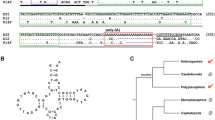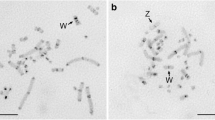Abstract.
Thirty sequences of a short interspersed repetitive element (SINE) were isolated from genomic DNA of Hippopotamus amphibius (hippopotamus). RNA polymerase III split promoter sequence was observed in all of the 30 sequences; and poly(A)-like structure at 3′-end, as well as direct repeat flanking to the repetitive sequence in many of the 30 sequences. A comparison of the consensus sequence of the 30 sequences with sequences in a DNA database (DDBJ/GENBANK/EMBL) revealed 93% homology to the consensus sequence of a whale SINE, CHR-2, and 73% homology to mouse glutamic acid tRNA. Phylogenetic analysis of tRNA-related regions of the sequences with all of the mouse tRNAs revealed that glutamic acid tRNA was genetically closest to the hippopotamus SINE. In addition, the tRNA-related region of the consensus sequence was folded into a cloverleaf structure as with mouse glutamic acid tRNA. These findings led us to conclude that the SINE of hippopotamus was genetically related to a whale SINE, CHR-2 [the hippopotamus SINE was named CHR-2(hippo)] and was a retroposon derived from glutamic acid tRNA. Hipo53 and hipo95, which were the genetically most separated CHR-2(hippo) sequences in the present study, were used as a probe for dot-blot hybridization to examine the distribution of their homologous sequences among animal species. Although the distribution spectra of hipo53 and hipo95 homologous sequences in animal species differed to some extent, large amounts of both sequences were found in Hippopotamus amphibius and Globicephala macrorhynchus (whale); and small amounts in most of the animal species in Artiodactyla examined. These findings indicated that the hippopotamus and whale had more recently branched off from the clade that includes chevrotain and pecorans than the other animal species in the clade. The 30 CHR-2(hippo) sequences were aligned, and the substitution rates among the sequences were calculated with a different substitution rate model for transition and for transversion. The calculation combined with the mutation rate of the pseudogenes (r = 4.6 × 109) indicated that CHR-2(hippo) sequences diversified at least 132 million years ago (Myr).
Similar content being viewed by others
Author information
Authors and Affiliations
Additional information
Received: 1 December 1997 / Accepted: 4 March 1998
Rights and permissions
About this article
Cite this article
Nomura, O., Lin, ZH., Muladno, . et al. A SINE species from hippopotamus and its distribution among animal species. 9, 550–555 (1998). https://doi.org/10.1007/s003359900817
Issue Date:
DOI: https://doi.org/10.1007/s003359900817




